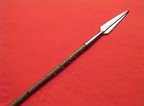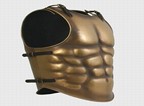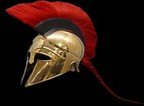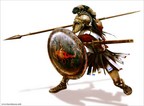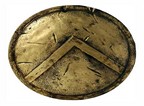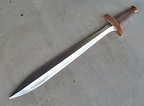The Greek world in antiquity was a world of continual war. The cities of the era were virtually constantly at war, sometimes in a greater, sometimes in a lesser degree, entangled in a constant conflict between them. The main reasons for this were of economic nature. The Greek cities – states in their vast majority were predominantly rural economies. Apart from trade, industry and various manual tasks (potters, carpenters, builders, etc.), the majority of the inhabitants were engaged in agriculture. The need of the cities – states for areas of fertile land, brought them numerous times in conflict with each other, especially in disputed border areas between them. In these conflicts, an important role was taken by the hoplites, the heavy infantry of the Greek martial arts.
The original hoplite armor was usually metal and belonged to the “breastplate” type. The thickness of such a metallic armor was less than half a centimeter, offering sufficient protection of the soldier torso, but left his underbelly exposed. Later on the “linothorax” or composite armor and the muscular metal armor appeared. The linothorax consisted of successive layers made of linen cloth joined together to create an impermeable layer thickness of about 0,5 cm . The linothorax shielded and protected the pelvis by usually a double blade row. The linothorax buttoned on the left side of the hoplite’s torso. Some hoplites did not trust the protection provided by the linothorax itself and they the shielded it with pieces of metal (scales) and with metal plates. In these cases, the thorax was complex and its weight was similar to that of a metal breastplate or a muscular plate. The linothorax was generally the most appropriate for the warm Greek climate (battles were taking place from mid-spring to early autumn) and also adapted quite well to the body of the soldier. Many times linothorax was manufactured from leather which was cheaper than linen cloth and gave about the same protection. The muscular plate hoplite armor had a metal embossing of the male body and was usually worn by officers. Like the breastplate, the muscular plate armor composed of two parts, one for the front of the trunk and one for the back, which snapped together at the hoplite’s side. The muscular thorax with a downward extension offered adequate protection of the abdomen and the pelvis portion and was usually worn over a leather suit known as “spolada”.
The word Hoplite means armed warrior. The soldiers were armed with large round shield, spear, sword, shield, helmet, greaves and rarely armbands and cuffs. From the above hoplite weapons, the defensive and offensive ones that characterize the soldier are the great round shield and the spear. The shield had round shape with a concaved interior and curved exterior surface to ostracize enemy blows. It was made from pieces of interconnected wood, topped with leather and metal. The outer surface of the shield, and occasionally the inner surface were decorated with various patterns or emblems. Many soldiers used to polish the outer surface of the shield with oil so that it would shine in the sun and look more impressive. The shield was attached to the left hand of the soldier in such a way that the shield’s weight of (7 – 8 kilos, diameter of 90cm-1m) would spread on the entire length of the hand. For binding to the left hand they used porpax, a belt within the shield passing through the center of the shield, connecting two diametrically opposed points. It bared a socket for holding the arm steady, and the antilavi, i.e. a handle which the hoplite grabbed with his palm.
The spear consisted of a wooden shaft approximately 2 meters long at one end of which an iron tip of length 20 – 40 cm was placed and at the other end there was a portion of iron known as “saurotir” that had similar length and could be used as alternative tip if the portion of the edge to the main peak broke. Usually at the point where the soldier caught the spear a piece of fabric was placed so the spear would not slip because of the sweat of the hoplite’s palm. The spear was used by the hoplite with his right hand raised upwards in order to perform downward blows to the opponent but not to injure the other warriors who were behind him in phalanx formation with the “saurotir”.
The helmet was usually made of copper. Its Inner side was upholstered in order not to hurt the skin of the head of the soldier with its metal and to better adapt to the hoplite’s head. Often, before weaning their helmet, the hoplites wrapped their hair with cloth tape for even better stabilization of the helmet on their head. The helmet was relatively cheap and could be obtained by almost every soldier – citizen. There were several types of helmets including perhaps the most famous Corinthian helmet. The Corinthian helmet was born from the need for full coverage of the face of the soldier, something that was necessary for a close battle. The Corinthian helmet consisted of two metal pieces glued together. It had two holes for vision, a piece of metal to protect the nose and a vertical hole to allow the hoplite breath. Many times the Corinthian helmet, like other types, had slots on their top for mounting an impressive plume consisting mostly of horse hair which was painted in vivid colors. Although the plume gave the hoplite more stature and generally made him look more imposing, it probably was not so practical in battle. The Corinthian helmet had various decorative motifs, especially the helmets of wealthier citizens and generals and was painted (as well as other types of helmets) and in order to impress but also for protection from oxidation. Beyond the Corinthian there were other types of helmets like the Chalcidicum, Cretan, Illyrian, Attic, Phrygian helmet and the hat type helmet. The latter was mass produced and was the helmet of many soldiers during the Peloponnesian War as it was very cheap and convenient, although it did not provided full face protection like the Corinthian did, which was, however, inconvenient and “rigid.”
The sword had an auxiliary role. The main types of swords of the hoplite were two, the classic Greek edged receding – Waterfowl sword and the Greek chisel. The length of both was about half a meter. The chisel was used especially by horsemen and was particularly effective in cutting the enemy’s head, as the horseman would charge quickly.
The leggings offered protection of the front part of the foot to about the knee’s height and were made from thin sheet metal. The first Leggings (8th to 6th century BC) had simple decoration without embossing muscles and ribs as latter ones (from early 5th century BC onwards). The biggest drawback was that of not offering agility on the battlefield and for this reason also many soldiers who did not prefer them and relied solely on the shield to protect their lower ends.
These were generally the parts of the hoplite armor and weapons. Of course there were variations from period to period, for example during the Peloponnesian war many soldiers did not wear armor, but had only a shield and a helmet and maybe greaves. The armor started to be reused widely by the end of 5 BC century. Also the armor of the Greek hoplites affected or was adopted by other races as the people of Italy, Persians etc. In conclusion, the Greek hoplites were the most effective fighters of the Mediterranean basin and the Middle East for centuries, something that made them sought-after for their services in war, even outside their homeland.
